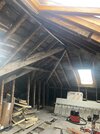I know you can have an aerial in the loft, but is there any distance from a wall it needs to be set away from ?
I have a tightish cupboard area which will hold the boiler, washing machine and fuse board on a flat i am renovating. I was thinking of putting the aerial in there as well. The building is high and we have aerials on the wall lower down than this flat, so i dont think i need to go out onto the roof to put one on the chimney.
I have a photo to show roughly where it will go.
It’s in this space where there is a triangle of wall. The 2nd photo shows this space just off to the left of the room
Others here are correct. Looking at that roof in the pictures it's possible to see the back of the slates. That's going to need some work and insulation. By the time that's done, the foil lined Kingspan and the rest are going to make the space a signal dead spot. (Mobile phone too, possibly.)
Either go with the outdoor aerial plan, or see if you can split off from one of the existing aerials. To do that you'll need to know how much signal margin you have to play with. For that purpose you should buy some UHF inline attenuators. They're about £4 a piece online / eBay. Get a 3, a 6, and a 12dB. They can be stacked together to give various combinations up to 21dB.
A two-way outdoor splitter will drop the signal by roughly 4dB after plug ends are added into the count. Decent all-copper coax (WF100) drops the signal level by 0.15dB per metre. Cheaper steel (CCS) and aluminium based cheap-o RG6 won't be as good.
Go to the back of a TV fed from the aerial that you want to split. This needs to be the direct feed from the antenna, not something going via an amplifier. Bring up the TVs signal quality + strength metering. Add an attenuator to the end of the coax fly lead. Start with 12dB. If you still have 100% quality then add the 6dB. If still good then add the 3dB.
The strength reading isn't so important. You can (and will) lose strength by adding attenuation. You can get down to 50% on the TV metering and still get a rock solid reception. The key is the quality reading. If you hit 80% on that then that's your cut-off point, so if 12dB gets 100% on quality, but 15dB gets you 80%, then 12dB is your safety margin.
Now look at where the cable will need to run to get to the loft. Estimate the cable length. You have say 12dB to play with, take away 4dB for the split, leaves 8dB. If good coax loses 0.15dB per metre, then that's the same as 1.5dB per 10 mtrs. You'll get 5 lots of 1.5 into 8 with a bit left over. That's 5x 10 m which gives you up to 50m of cable to play with. Where you've found the safety margin larger or smaller then adjust accordingly. Now you know if you can safely split the signal.
Personally, I'd save the money on splitters and just go with a chimney mount, but your mileage may vary.




